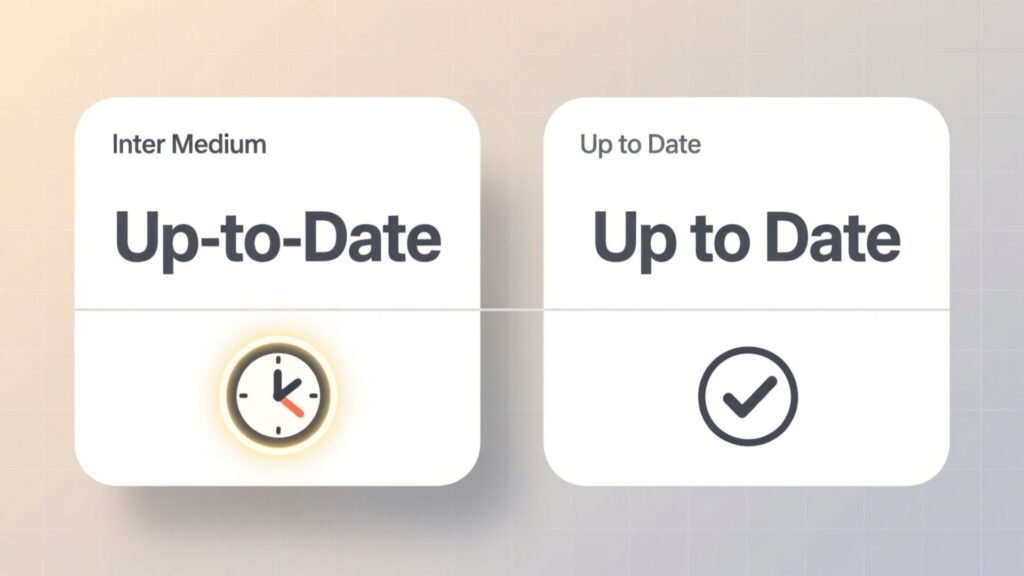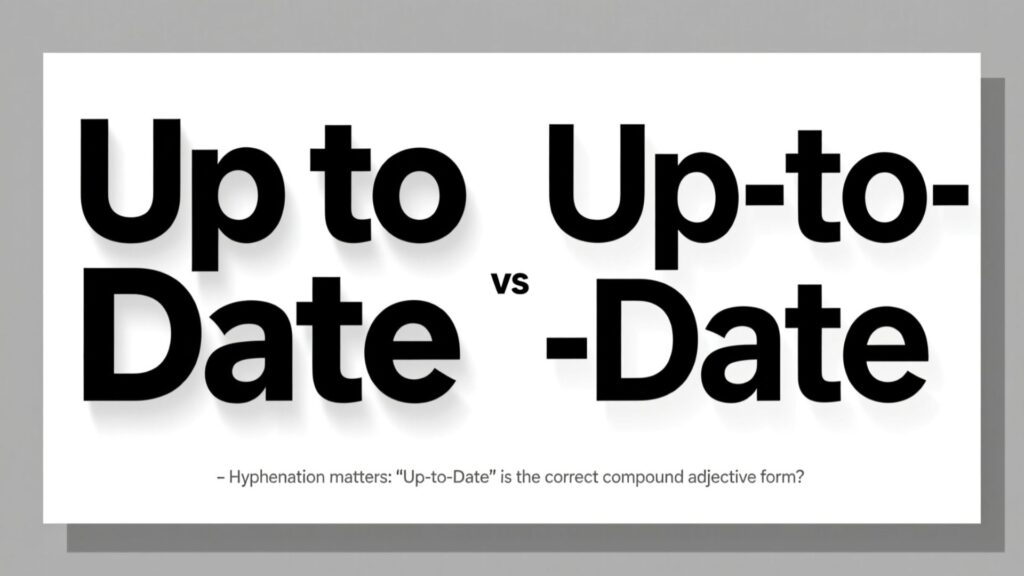Language is full of subtle details that can confuse even the most careful writers. One such puzzle is deciding whether to use “up to date” or “up-to-date.” At first glance, they look almost the same, but the tiny hyphen changes the role each phrase plays in a sentence. To write with accuracy and confidence, you need to know when to use one form over the other.
In this article, you’ll learn the difference, see real-life examples, and discover how to apply the correct form in emails, reports, and other professional writing.
The Core Difference

The choice between “up to date” and “up-to-date” depends on grammar rules and sentence function:
- Up to date is used as an adverbial phrase. It describes the state of being current.
- Up-to-date is used as an adjective phrase. It modifies a noun directly.
Think of it this way: if the phrase comes after a verb like is, are, keep, bring, or stay, you usually need “up to date.” If it comes before a noun, you need “up-to-date.”
Using “Up to Date” (Adverbial Phrase)
When you write “up to date,” you’re describing something that is current, accurate, or updated. It usually follows linking verbs like is or remain.
Examples in Sentences
- “This database is up to date with the latest statistics.”
- “I need to bring my passport information up to date before traveling.”
- “Are your medical records up to date?”
Email Example
Subject: Please Confirm Your Records
Hi Sarah,
We’re reaching out to ensure that your account details are up to date. Please review your information and update it if necessary by Friday.
Best regards,
James Walker
Client Services Team
This example shows how “up to date” naturally fits when checking accuracy or freshness of information in business communication.
Using “Up-to-Date” (Adjective Phrase)
The hyphenated form works as an adjective. It describes a noun directly and should always come before the word it modifies.
Examples in Sentences
- “Our company just purchased an up-to-date smartphone for every employee.”
- “The report provides up-to-date statistics on market trends.”
- “This textbook includes the most up-to-date guidelines for medical students.”
Business Email Example
Subject: Updated Market Insights
Hi Jonathan,
Attached you’ll find the latest report, which contains up-to-date statistics and analysis on regional sales. Please review the figures before our strategy meeting next week.
Thanks,
Melissa Torres
Market Research Analyst
Here the hyphen makes it clear that “statistics” are being described as up-to-date.
Common Mistakes to Avoid
Even native speakers sometimes struggle with hyphenation. Let’s clear up a few frequent errors:
- Incorrect: “Your data is up-to-date.”
Correct: “Your data is up to date.” - Incorrect: “We bought an up to date smartphone.”
Correct: “We bought an up-to-date smartphone.” - Writing “uptodate” without spaces or hyphens is always wrong.
Remember, the hyphen only belongs when the phrase works as a single adjective.
Why This Matters in English Writing
Accuracy in grammar shows professionalism, especially in report writing, business communication, and digital correspondence. Choosing between up to date and up-to-date isn’t just about pedantic grammar rules. It affects clarity in writing and prevents misunderstandings.
For example, imagine you’re describing an employee’s records:
- “His records are up to date.” → You mean they are current.
- “He submitted up-to-date records.” → You’re describing the kind of records he submitted.
A small hyphen can shift the meaning entirely.
Historical Roots of “Up to Date”

Interestingly, the phrase has bookkeeping origins. In the late 19th century, clerks used “up to date” to describe financial ledgers that were accurately balanced and current. Over time, it expanded beyond bookkeeping and became common in everyday writing, especially with the rise of modernized technology and record-keeping systems.
Synonyms and Alternatives
Depending on context, you can replace up to date or up-to-date with synonyms that carry a similar meaning.
For “Up to Date” (Adverbial Use):
- Current
- Updated
- Recent
- Contemporary
- Modernized
Example: “Is your software current?” works the same as “Is your software up to date?”
For “Up-to-Date” (Adjective Use):
- Modern
- State-of-the-art
- Cutting-edge
- Latest
- Contemporary
Example: “She has a cutting-edge smartphone” works the same as “She has an up-to-date smartphone.”
“Up to Date” in Everyday Scenarios
To show you how flexible the phrase can be, let’s walk through different real-life examples:
Workplace
- “Please keep the project timeline up to date with any changes.”
- “We use an up-to-date system for tracking employee hours.”
Technology
- “Make sure your antivirus software is up to date.”
- “He bought an up-to-date laptop with the latest processor.”
Education
- “Are your lecture notes up to date?”
- “The professor provided an up-to-date textbook on economics.”
Up to Date in Other Languages
Many learners of English often search for translations such as:
- up to date artinya (Indonesian for “up to date meaning”)
- arti up to date
- uptodate artinya
- up date artinya
- apa itu up to date
These searches show that people worldwide want to understand when to use each form correctly in English writing.
Quick Reference Table
| Usage | Form | Example Sentence |
|---|---|---|
| After a verb (adverbial phrase) | up to date | “My passport is up to date.” |
| Before a noun (adjective phrase) | up-to-date | “She bought an up-to-date smartphone.” |
| Incorrect form | uptodate | ❌ Always wrong |
Final Thoughts
The decision between “up to date” and “up-to-date” may seem minor, but it shapes clarity and professionalism in writing. Use up to date when describing a state of being current, and up-to-date when modifying a noun.
Whether you’re writing an up-to-date report, keeping up to date records, or asking a colleague to bring something up to date, understanding this distinction ensures polished and effective communication.
Next time you draft an email, write a report, or update your résumé, you’ll know exactly which form to use. Staying grammatically sharp is, after all, the most up-to-date skill you can have.
Bugti is the founder of Quoethint.com, a hub for English language tips, writing advice, and grammar guidance. With years of experience in English studies and a passion for clear communication, Bugti created this platform to make grammar and writing easy to understand for everyone.
